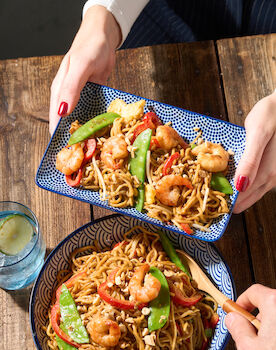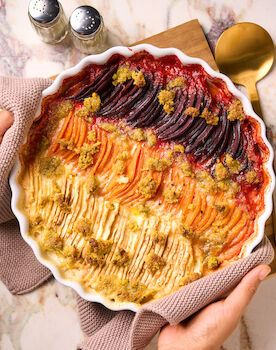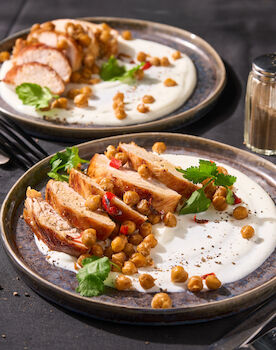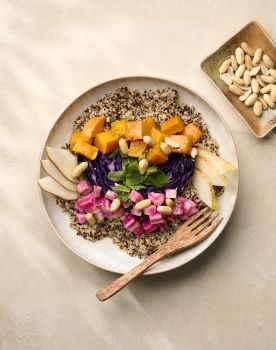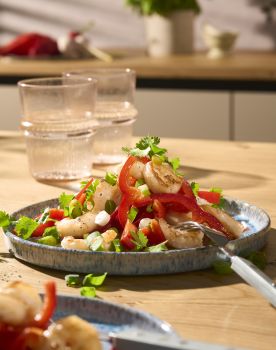Nutri-Check
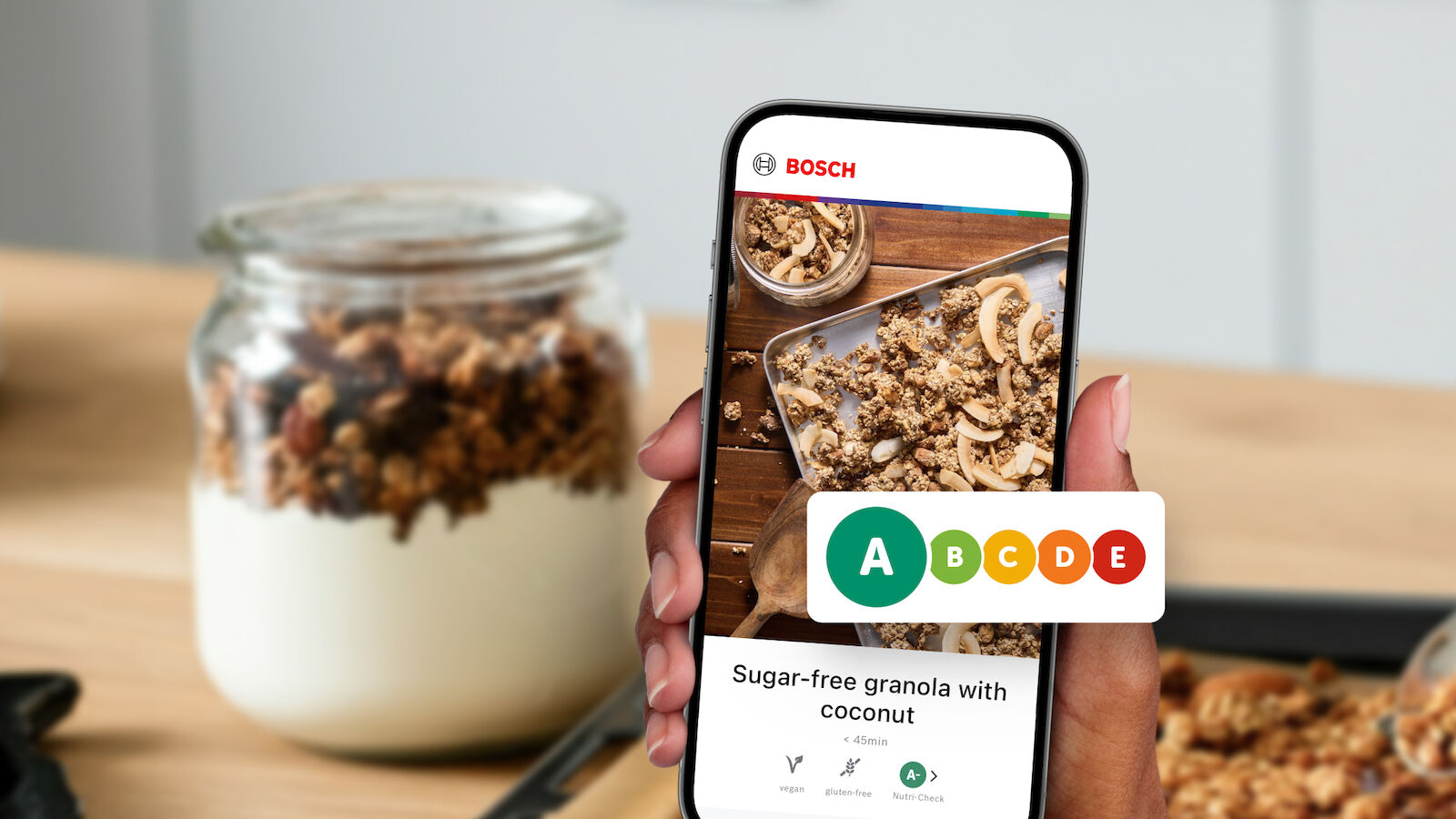
What Nutri-Check tells you about your favourite recipes
Cooking a variety of meals with fresh ingredients is the best way to achieve a balanced diet. But which BetterFood recipes deliver truly good ingredients and nutrients? Our Nutri-Check rating gives you the health score of each recipe in an instant. We explain below what the score means.
- Purpose of Nutri-Check
- What the Nutri-Check score reveals
- How to compare the ratings of different recipes
- Why is the Nutri-Check rating sometimes higher or lower than expected?
- Each rating on the health scale explained
- Which ingredients and nutrients are considered?
- What’s the difference from Nutri-Score?
- Conscious eating rather than self-denial

How can healthy meal choices be made much simpler? And how can I know whether a newly discovered recipe is a sensible addition to my daily meal plan?
Nutri-Check provides simple guidance on every BetterFood recipe based on a traffic-light system. The colour coding and letter ratings help determine in an instant whether the nutrients in a dish are beneficial.
- Purpose of the Nutri-Check
The main purpose behind our rating system is to help you make conscious choices when selecting a recipe. Conventional nutrient listings can often be overwhelming, and how can we even know how much of a nutrient is good or bad?
This is where Nutri-Check comes in. The simple traffic-light system reveals in an instant how closely a recipe reflects the current recommendations of the German Nutrition Society (DGE).
- How to understand Nutri-Check
Based on the latest recommendations of the DGE for an optimal supply of nutrients, ecotrophologists have developed our exclusive formula for calculating the Nutri-Check score. Everyone is different, as is the individual need for nutrients. The DGE therefore recommends different combinations of nutrients for different groups of people. Our calculation is based on the recommendations for women between 25 and 51 years of age, assuming that they are healthy.
The Nutri-Check scale has five scores, from A to E, which indicate how closely a dish reflects the current DGE recommendations. Dishes with a dark green A have a particularly good balance of ingredients and nutrients, meaning that the DGE recommendations are largely met. Recipes rated E, on the other hand, contain a lot of less beneficial ingredients and nutrients; they barely meet the DGE recommendations. The plus or minus after the letter can be understood in the same way as school grades. A+, for example, is an A with distinction. A-, meanwhile, is closer to B.
- How to compare the ratings of different recipes
Imagine you’ve found a cake recipe in our app that has a Nutri-Check score of A and a vegetable curry rated B: Does that mean you’d be better off eating the cake for lunch than the curry? Of course not – or not necessarily, at least.
To achieve a wholesome, balanced diet, we certainly recommend that you enjoy a range of different foods. The cake with the Nutri-Check A rating may be packed with vitamins and minerals as well as healthy fatty acids in the form of nuts, and therefore would not be a poor choice – even at lunch. However, we shouldn’t assume that we are eating healthily if we have this cake for lunch every day. Sufficient fruit and vegetables also play an important role in our diet. Three handfuls of vegetables and two of fruit per day are the recommendation. If you manage that, then a lunch made up of the cake in question can also be a sensible addition to a balanced diet. Food variety is the key.
Anyone who has difficulty managing the recommended amount of fruit and vegetables in a day would be better off opting for the vegetable curry. Furthermore, using our modular system for exchanging ingredients and elements, you can also adapt each recipe to your needs, including the desired Nutri-Check rating. With our risotto, for example, the rice can easily be swapped out for cauliflower rice. This not only makes a nice change, but also introduces more vegetables.
- Why is the Nutri-Check rating sometimes higher or lower than expected?
Like perhaps every rating system, Nutri-Check also has its weaknesses. Since the rating is based on a quantity of 100 g, unexpected results may be obtained, especially with recipes that are meant to be combined with other foods. A pesto is not a wholesome dish, for instance, but is eaten with pasta or oven-roasted vegetables, or in a sandwich. It is therefore important in such cases to consider the whole package.
Furthermore, there are ingredients like broccoli or even some nuts and seeds that contain so many positive ingredients and nutrients that they can “compensate” for foods with a poor ingredient and nutrient content, such as household sugar. It is possible, for instance, that a cake made mostly of ground almonds has a higher rating than suspected. In this case, it’s worth looking at our detailed Nutri-Check page, where you’ll see at a glance which ingredients and nutrients have a positive or negative influence on the rating of a recipe.
- What do the different letters of the health scale mean?
Our Nutri-Check scale basically uses the same approach as the nutritional or food pyramid. It illustrates the principles of a healthy, balanced diet and indicates which food groups should be consumed and in what quantities. And this can be applied to our rating. If a recipe contains many of the recommended food groups, it will appear on a lower rung of the pyramid and be awarded an A. Dishes containing fewer of the recommended food groups, meanwhile, can be found higher up the pyramid and receive an E rating on our scale.
The five Nutri-Check ratings can be interpreted as follows:
A
You can’t go wrong with this ideal combination of nutrients. This recipe contains lots of welcome, wholesome ingredients and nutrients and is therefore perfect for a healthy, balanced diet!B
We recommend this thoroughly health-conscious choice, where only a few unhealthy elements are outnumbered by plenty of beneficial ones.C
In terms of the current DGE recommendations, these dishes contain some healthy but also some less healthy ingredients.D
With few healthy ingredients and nutrients, or a combination that is less beneficial, this dish should not be served too often.E
Since they are of little nutritional value, it is better to enjoy such dishes only in moderation.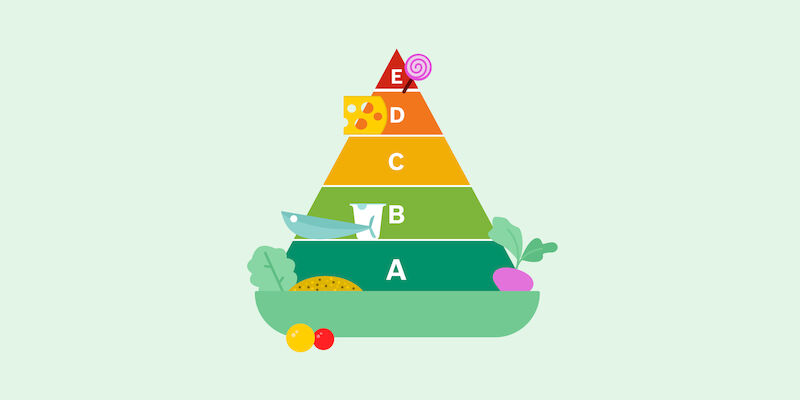
- Which ingredients and nutrients are considered?
Vitamins and minerals, for example, are classified as healthy nutrients. If a dish contains a lot of both, it is rated positively. Ingredients and nutrients such as sugar, salt, animal protein and highly processed meat products, on the other hand, are rated negatively as soon as the recommended amount is exceeded in one meal. There are other nutrients, however, where both the quantity and ratio are important. This applies not only to the fatty acid composition, but also to carbohydrates and fibre.
Our rating considers the following ingredients and nutrients:
- Ratio and quantity of carbohydrates to fibre
- Sugar
- Alcohol
- Fatty acid composition
- Saturated fatty acids
- Mono- and polyunsaturated fatty acids
- Cholesterol
- Animal protein and highly processed meat products
- Vitamin C
- Vitamin B1
- Vitamin B2
- Vitamin B12
- Vitamin A
- Vitamin D
- Vitamin E
- Folic acid
- Calcium
- Iron
- Magnesium
- Zinc
- Potassium
- Sodium
The rating is awarded based on a quantity of 100 g rather than per portion.
- What’s the difference from Nutri-Score?
While the Nutri-Score label can be found on the packaging of many (processed) products in grocery stores, our Nutri-Check system rates only the dishes found in our BetterFood app. Both health labels aim to illustrate ingredients and nutrients in a simplified way to help us make a healthier choice within the same category.
The Nutri-Score accounts for a few factors (fibre and protein content, the proportion of fruit, vegetables and nuts, calories, sugar, saturated fatty acids and sodium), whereas Nutri-Check takes a closer look while also considering factors such as monounsaturated and polyunsaturated fatty acids, individual vitamins and minerals, cholesterol, alcohol, and animal protein and highly processed meat products. In addition, we also account for the ratio and the quantity of carbohydrates and fibre in our calculation.
- Conscious eating rather than self-denial
Conscious enjoyment of a varied diet without denying yourself is without doubt always the focus at BetterFood. Cooking and eating should be fun! We therefore include snacks, desserts and soul food which generally have a lower health rating. And it is precisely the Nutri-Check labelling that should help you to plan such recipes in moderation and achieve the right balance.
